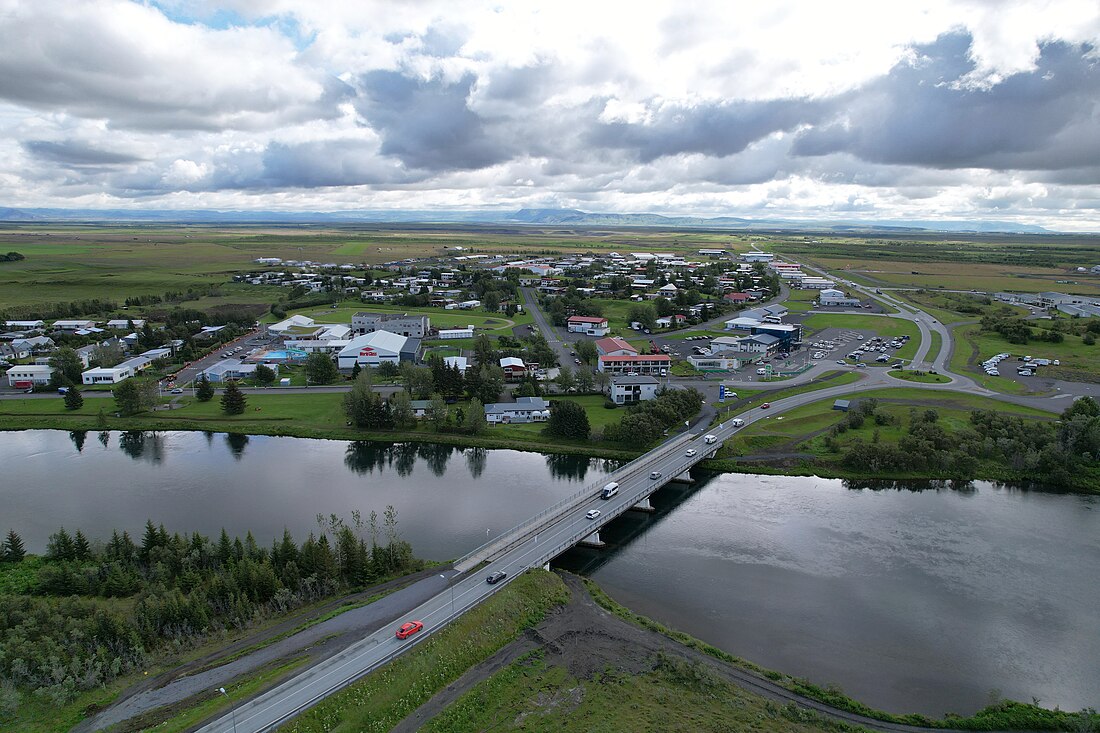Hella, Iceland
Town in South Constituency, Iceland From Wikipedia, the free encyclopedia
Hella (Icelandic pronunciation: [ˈhɛtla]) is a small town in southern Iceland on the shores of the river Ytri-Rangá and has, as of 2021, 942 inhabitants.[1]
This article needs additional citations for verification. (December 2009) |
Hella | |
|---|---|
Town | |
 Hella in 2024 | |
 Location of the Municipality of Rangárþing ytra | |
| Coordinates: 63°50′N 20°24′W | |
| Country | Iceland |
| Constituency | South Constituency |
| Region | Southern Region |
| Municipality | Rangárþing ytra |
| Population (2019) | |
• Total | 865 |
| Time zone | UTC+0 (GMT) |
| Post Code | 850, 851 |
Wikivoyage has a travel guide for Hella.
Hella is situated 94 kilometres (58 mi) to the east of Reykjavík on the Hringvegur (Route 1) between Selfoss and Hvolsvöllur.
Overview
The name of the town comes from caves near the river. It is said that Irish monks lived there in the times of first settlement. There are small industries as well as shops. As in other regions of the country, tourism is a growing sector. The volcano Hekla is nearby so it is possible to go hiking there as well as to make excursions to other locations popular with tourists such as Landmannalaugar or Þórsmörk. The founding of Hella started in 1927 when Þorsteinn Björnsson built a store over by the bridge Ytri-Rangá in the land of Gaddstaðaflatir. That founder of Hella was built a memorial at the celebration of Hella's 50 years since the founding of it at 1977.
Climate
Summarize
Perspective
Hella has a subarctic climate (Köppen: Dfc; Trewartha: Eolo), with temperatures rising above 10 °C (50 °F) only in July and August.
| Climate data for Hella, 1961–1990 normals, extremes 1958–2005 | |||||||||||||
|---|---|---|---|---|---|---|---|---|---|---|---|---|---|
| Month | Jan | Feb | Mar | Apr | May | Jun | Jul | Aug | Sep | Oct | Nov | Dec | Year |
| Record high °C (°F) | 11.3 (52.3) |
10.4 (50.7) |
16.8 (62.2) |
15.8 (60.4) |
21.4 (70.5) |
24.3 (75.7) |
25.2 (77.4) |
27.0 (80.6) |
20.2 (68.4) |
16.7 (62.1) |
12.7 (54.9) |
12.5 (54.5) |
27.0 (80.6) |
| Mean daily maximum °C (°F) | 1.1 (34.0) |
2.1 (35.8) |
3.0 (37.4) |
6.1 (43.0) |
10.2 (50.4) |
12.7 (54.9) |
14.5 (58.1) |
13.9 (57.0) |
10.7 (51.3) |
6.7 (44.1) |
2.6 (36.7) |
1.3 (34.3) |
7.1 (44.8) |
| Daily mean °C (°F) | −1.8 (28.8) |
−0.7 (30.7) |
−0.4 (31.3) |
2.7 (36.9) |
6.5 (43.7) |
9.4 (48.9) |
10.9 (51.6) |
10.3 (50.5) |
6.9 (44.4) |
3.4 (38.1) |
−0.2 (31.6) |
−1.6 (29.1) |
3.8 (38.8) |
| Mean daily minimum °C (°F) | −4.5 (23.9) |
−3.3 (26.1) |
−3.0 (26.6) |
−0.3 (31.5) |
2.8 (37.0) |
6.1 (43.0) |
7.6 (45.7) |
6.8 (44.2) |
3.7 (38.7) |
0.9 (33.6) |
−2.8 (27.0) |
−4.5 (23.9) |
0.8 (33.4) |
| Record low °C (°F) | −21.8 (−7.2) |
−22.3 (−8.1) |
−20.1 (−4.2) |
−17.8 (0.0) |
−8.2 (17.2) |
−2.9 (26.8) |
0.0 (32.0) |
−3.1 (26.4) |
−8.2 (17.2) |
−17.8 (0.0) |
−16.3 (2.7) |
−20.2 (−4.4) |
−22.3 (−8.1) |
| Average precipitation mm (inches) | 107.1 (4.22) |
105.8 (4.17) |
104.0 (4.09) |
86.7 (3.41) |
71.6 (2.82) |
89.3 (3.52) |
82.6 (3.25) |
110.5 (4.35) |
104.1 (4.10) |
121.8 (4.80) |
108.1 (4.26) |
114.2 (4.50) |
1,205.8 (47.47) |
| Source: Icelandic Meteorological Office[2] | |||||||||||||
See also
References
Wikiwand - on
Seamless Wikipedia browsing. On steroids.

